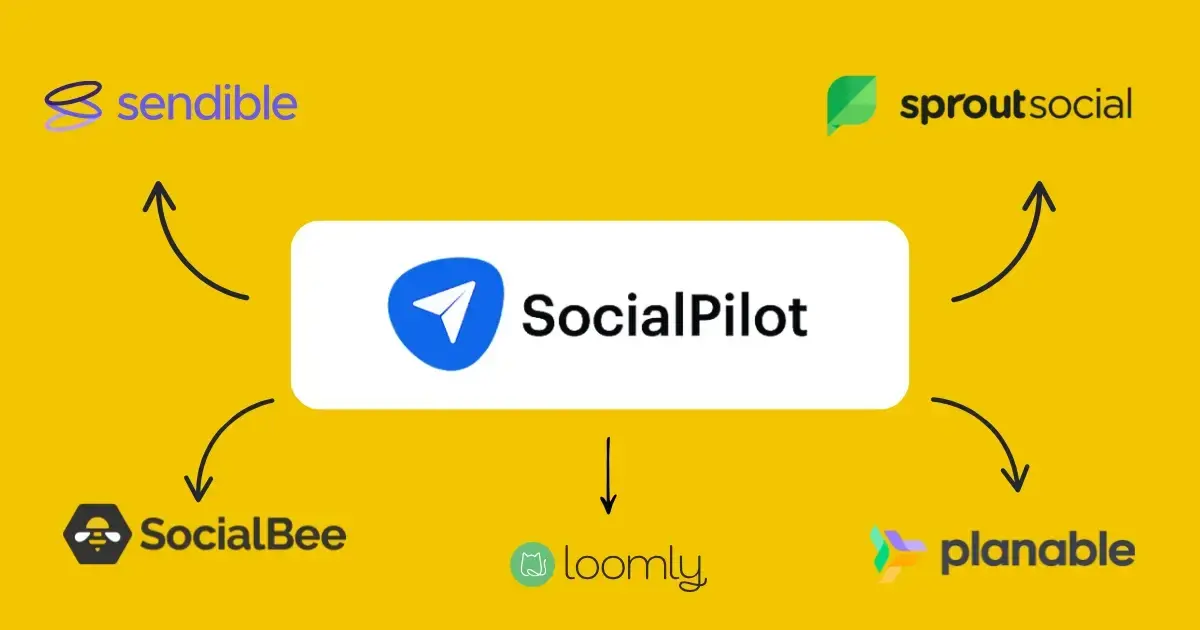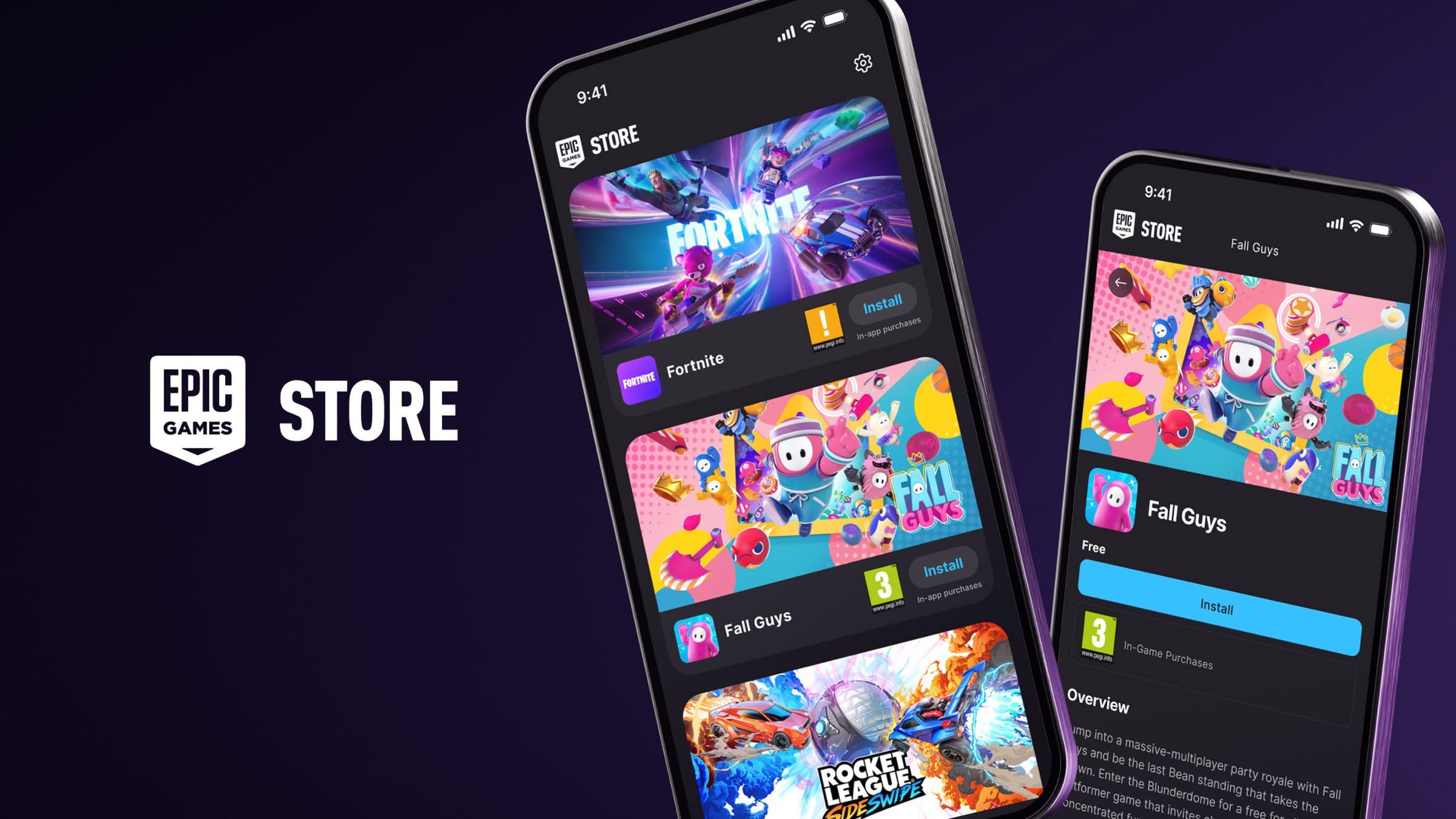#2 SocialPilot Alternative: Planable – Best for team collaboration and fast approvals
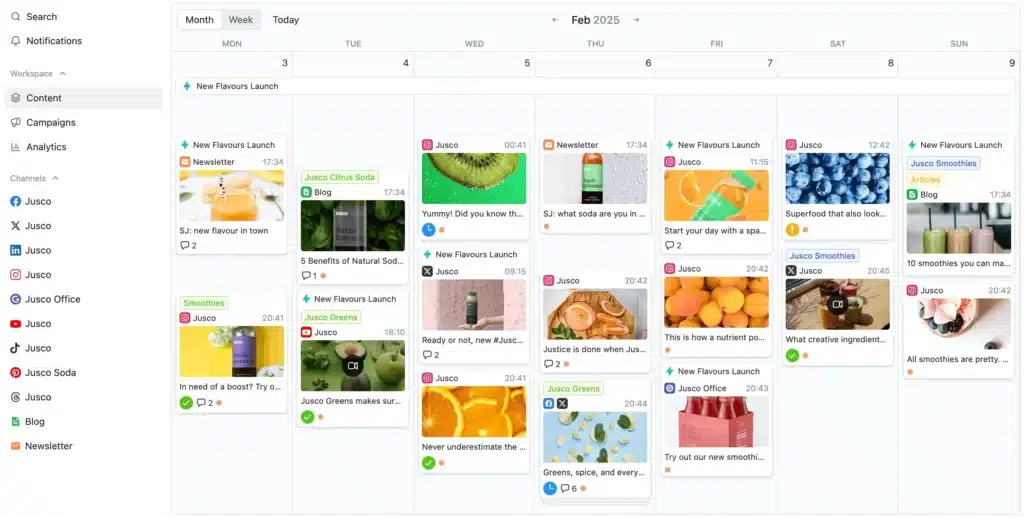
Who is Planable best for?
Planable is a great fit for agencies, marketing teams, and freelancers who need a simple way to plan content without endless back-and-forth emails.
Planable feature overview
Planable focuses on making collaboration smoother rather than trying to be an all-in-one social media management tool. Its strength lies in its clean, visual calendar and easy approval workflows that cut down on confusion. Teams can draft posts, share them with clients for review, and finalize them with a single click. While reporting and engagement tools are basic, Planable does an excellent job at simplifying planning, scheduling, and approvals.
Here are Planable’s key features:
- Publish and schedule posts to Facebook, Instagram, LinkedIn, TikTok, Threads, Twitter (X), YouTube, Google Business Profile, and Pinterest.
- Use a visual drag-and-drop calendar to organize and preview upcoming content.
- Share client review links that don’t require a login, making approvals faster and easier.
- Add a first comment when scheduling posts (especially useful for Instagram).
- Work with multiple brands and accounts in one workspace.
- Collaborate with team members using feedback threads, approvals, and post versioning.
- Draft, preview, and approve posts across platforms exactly as they’ll appear live.
- Schedule posts in bulk to save time.
- Manage roles and permissions so the right people can create, review, or approve content.
- Duplicate posts to quickly repurpose content across platforms.
Planable pros
Many users point to how simple Planable is to pick up and use. The calendar view makes it easy to see everything at a glance, and sharing posts with clients for feedback or approval is quick and painless. Many also like that even non-technical team members can jump in without much training.
What users are saying about Planable’s pros:
- “That you can send a link directly to clients without login, and the calendar view. Also being able to do all the captions at once is just the best.” – Abi D., Founder (Source)
- “Great interface, easy to schedule, visibility on content across the month.” – Heather M., Content Marketing Consultant (Source)
- “I like the way I can go to one place, review a social media content calendar, add my feedback, and approve by simply clicking a checkmark.” – Martie R., Creative Services Project Manager (Source)
- “Super easy to use. All my team members were able to adopt Planable easily and continue using it just because it was so easy and multifunctional.” – Tiya J., Head Sales and Marketing (Source)
- “The best thing about Planable is that I can schedule publications in social networks in advance. You can also separate the accounts of different companies. The process is very easy and intuitive.” – David, Research Coordinator (Source)
Planable cons
Users point to the price being a bit high for smaller businesses. Analytics are limited unless you pay more, and some features, like LinkedIn tagging, multi-step approvals, or support for extra platforms, still feel unfinished.
What users are saying about Planable’s cons:
- “Would really appreciate the price points being lower. Especially since we are a small business and are paying in INR, the amount is quite high.” – Tiya J., Head Sales and Marketing (Source)
- “Planable does not allow for multiple people to check whether they approve or not. Our workaround is for each person to type ‘approved’ in the comment box.” – Martie R., Creative Services Project Manager (Source)
- “Tagging on LinkedIn is a bit hit and miss.” – Heather M., Content Marketing Consultant (Source)
- “I would like to see Telegram and WhatsApp publishing included, that would be great.” – David ., Research Coordinator (Source)
- “Doesn’t include analytics in pro plan which is disappointing without an extra fee.” – Abi D., Founder (Source)
Planable pricing
- Offers a free plan
- Paid plans start at $33/month
Planable vs SocialPilot: Which one should you choose?
Choose Planable if collaboration and approvals are your biggest priorities. It’s designed for teams and agencies that need clients to review posts, leave comments, and sign off quickly without long email threads. The clean calendar view and simple workflows make planning easy, but analytics are limited. Pricing starts at $33/month, with a free plan available.
Choose SocialPilot if you want a more versatile tool for managing multiple accounts. Unlike Planable, which focuses mainly on collaboration, SocialPilot supports publishing across more platforms (including LinkedIn, Twitter/X, TikTok, and Pinterest), offers bulk scheduling, and provides analytics to measure performance. Its paid plans start at $30/month, making it slightly cheaper at entry level.
#3 SocialPilot Alternative: Sendible – Best for agencies with client dashboards and white-label reports
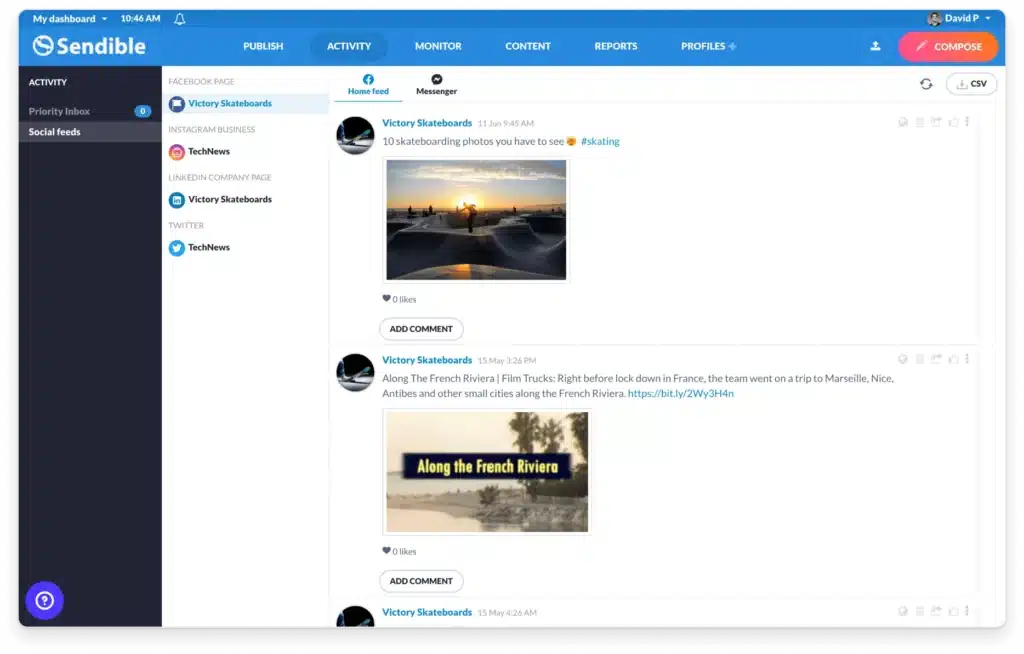

Who is Sendible best for?
Sendible is great for agencies and freelancers.
Sendible feature overview
Sendible shines by letting you handle nearly everything in one place: tailor posts for each platform, schedule them with a drag-and-drop calendar, design visuals in Canva, and even lean on AI to write or polish your captions.
Social media marketing agencies and freelancers will love the client dashboards and white-label option, which make it simple to manage accounts while keeping their own branding front and center. Plus, built-in reports and a shared inbox help track results and stay on top of conversations.
Here are Sendible’s key social media features:
- Publish directly to Instagram, Facebook, TikTok, Twitter (X), LinkedIn, Google Business, YouTube, WordPress, Threads, and Bluesky.
- Customize content for each platform without leaving the dashboard.
- Plan and manage campaigns using a drag-and-drop calendar.
- Set evergreen posts to recycle automatically with start and end dates.
- Get AI assistance to draft, rephrase, or proofread captions.
- Edit images inside Sendible or create designs with Canva.
- Store reusable content, templates, and hashtags in your content library.
- Pull posts from RSS feeds and auto-share new blog updates.
- Access free stock photos and GIFs via Pexels, GIPHY, and Flickr.
- Add a website share button to send content straight into Sendible.
- Provide clients with dashboards limited to their own content.
- Assign posts for review and set approval rules before publishing.
- White-label the platform with your own branding, colors, and domain (paid add-on).
- Manage all comments and messages in one unified inbox.
- Track your social media performance with built-in reports, including Google Analytics data.
- Export reports as PDFs, send by email, or share via live links
Sendible pros
Sendible is often recognized for its simplicity, time-saving features, and affordable plans. Users like how easy it is to batch content, manage client approvals, handle comments, and organize visuals without extra tools. Its white-label option also stands out, giving agencies and freelancers the ability to deliver social media management under their own brand.
What users are saying about Sendible’s pros:
- “I love the fact that I can plan out my campaigns on a spreadsheet then import them into Sendible. Then I can work with Canva right inside each post in Sendible to create my graphics to match the captions. Huge time saver!” – Melissa I., Admin Assistant and Digital Marketer (Source)
- “I chose Sendible because I could white label it. It was essential for me to maintain my brand. It is a game-changer for my company, allowing me to offer an added layer of social media expertise that extends beyond just creative content.” – Kristin K., Creative Director (Source)
- “I like that I can batch schedule content for myself and my clients.” – Jen B., Owner (Source)
- “Ease of use and reliability. We use it daily.” – Wendy Y., Editor (Source)
- “It is one of the most cost-effective ways to schedule posts to multiple platforms. Much more reasonably priced than some competitors.” – Freya R., Marketing & Content Creation (Source)
Sendible cons
Some users note that Sendible could improve with more flexible scheduling options, stronger Instagram features, and built-in tools such as hashtag research. Pricing is another concern, as many reviewers feel the cheaper plans are too limited, making the Scale plan the only real option for full functionality.
What users are saying about Sendible’s cons:
- “The Instagram integration is behind the competition.” – Bryan T., Digital Marketing Management (Source)
- “I wish Sendible had a hashtag finder (research) tool. I love the one that is built-in .” – Melissa I., Admin Assistant and Digital Marketer (Source)
- “The platform’s focus on organic alone makes the price point a bit high. If you are looking to handle both organic and paid social from one platform, it falls short.” – Kristin K., Creative Director (Source)
- “I would like to be able to drag posts around on any view, not just the monthly. We should be able to change date, time easily without having to edit each post.” – Wendy Y., Editor (Source)
- “There are some odd quirks and things that you learn to work your way around.” – Freya R., Marketing & Content Creation (Source)
Sendible pricing
- Offers a 14-day free trial
- Paid plans start at $29/month
Sendible vs SocialPilot: Which one should you choose?
Choose SocialPilot if your main priority is scaling affordably. It supports bulk scheduling, an easy content calendar, and a straightforward client approval system that lets clients review and approve posts before they go live.
Choose Sendible if you’re managing client work and want more advanced branding options. Sendible goes further with white-label dashboards, branded reports, and customizable client approval workflows that agencies can tailor to their own style.
While SocialPilot leans toward scale and simplicity, while Sendible leans toward polished, branded client experiences.
#4 SocialPilot Alternative: Loomly – Best for small businesses with simple scheduling and content ideas
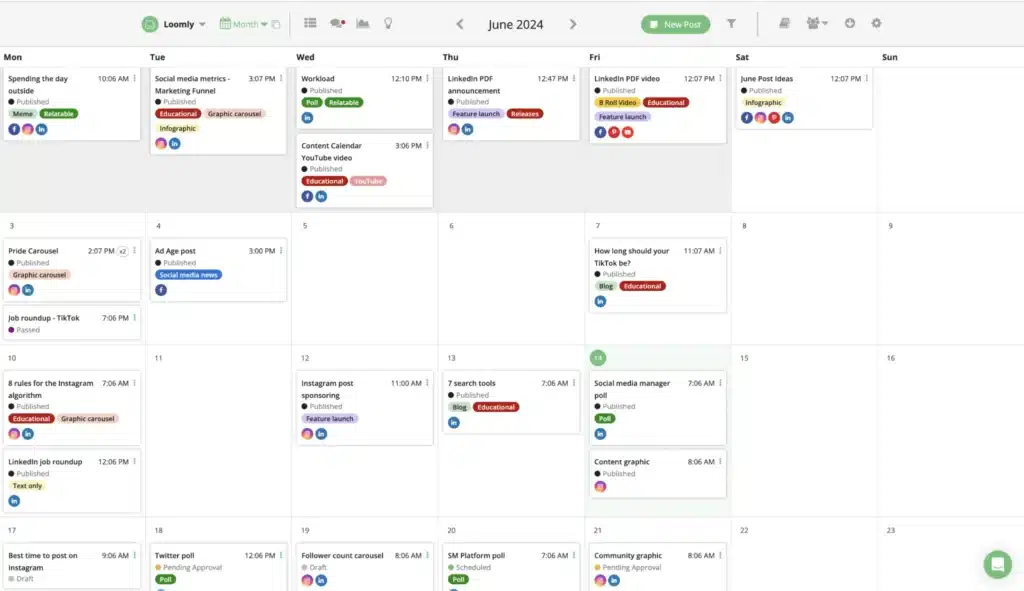

Who is Loomly best for?
Loomly is a good fit for small businesses, startups, and agencies that want an easy way to keep social content organized and on schedule.
Loomly feature overview
Loomly is a social media management tool that helps teams stay organized and consistent. Each account gets its own calendar, making it simple to plan and schedule social media posts across multiple platforms.
With labels, templates, hashtag suggestions, collaboration features, a shared inbox, and detailed reports, Loomly brings planning, publishing, and engagement into one place.
Here are Loomly’s key features:
- Plan and publish to Instagram, LinkedIn, Facebook, X (Twitter), TikTok, YouTube, Threads, Google Business Profile, Pinterest, and Snapchat.
- AI caption writer and post ideas feature for fresh content.
- Separate content calendars for each brand or account.
- Labels and ready-made templates to streamline planning.
- Hashtag suggestions to optimize reach.
- Audience targeting and post boosting.
- Role-based permissions and built-in collaboration tools for smooth approvals.
- Comment threads and feedback on posts.
- Real-time alerts via Slack or Microsoft Teams.
- Unified social media inbox for comments, mentions, and messages, with assignment options.
- Tracking links for click measurement.
- Automated performance reports as PDFs or spreadsheets.
- Image imports from Google Drive, Unsplash, or Canva.
Loomly pros
Loomly is often described as straightforward and easy to get the hang of. People like how it helps them stay organized, plan ahead, and keep their posts consistent. The content ideas come in handy when inspiration runs low, and the collaboration tools make it a good fit for teams or agencies that need quick approvals and clear communication.
What users are saying about Loomly’s pros:
- “Love that it’s super easy to collaborate with my clients and editors. I’ve had one or two tech/service issues and the support team has been very responsive.” – Verified User in Marketing and Advertising (Source)
- “Being able to organize our social media posts and schedule them with an easy process. The suggestions for content, day, time, etc., have also been invaluable.” – Anthony D., CIO (Source)
- “All of the features are very intuitive! I love the Post Ideas the most. When I’m at a loss for what to post, I use the ideas to create content based of the ideas provided.” – Verified User in Government Relations (Source)
- “Ease of use, multiple social platforms can be utilized and edited, adding pictures and/or videos is simple. I also like the duplicate post feature if I want to use the same hashtags or image and just tweak the copy.” – Tonya T., Principal (Source)
Loomly cons
Some users point out that Loomly could improve its social media analytics, which feel a bit limited compared to other platforms. Pricing is another concern, with some feeling the plans are on the higher side for what’s offered. Others mention that certain features don’t go far enough and that feedback or requests for improvements aren’t always addressed quickly.
What users are saying about Loomly’s cons:
- “Integrating with newer platforms or providing additional templates for content ideas would make it even better.” – Gage H., Owner / Videographer (Source)
- “The analytics don’t always agree with the actual platform’s analytics.” – Karen B., Director of Marketing (Source)
- “The lack of transparency in terms of roadmap plans. I put a simple request in and discussed it with multiple advisors, but they refuse to remove the annoying button on the lower right-hand corner that blocks the view of work on certain screens.” – Samuel J., Director (Source)
- “For one business with multiple platforms Loomly can be expensive.” – Steve M., Marketing Manager (Source)
- “Lacks in-depth analytics.” – Akhil R., iOS Developer (Source)
Loomly pricing
- Offers a free trial
- Paid plans start at $65/month
Loomly vs SocialPilot: Which one should you choose?
Pick SocialPilot if your top priority is affordability and handling a large number of accounts at scale. It’s budget-friendly, simple to use, and offers solid scheduling and reporting without extra frills. That makes it a good fit for freelancers, small businesses, or agencies that mainly need a bulk scheduler.
Go with Loomly if you’d rather have a clean, collaborative tool with more creative support built in. Its content ideas, AI caption writer, and intuitive calendars help teams plan smoothly, while approval workflows and integrations with Slack or Teams keep everyone in sync. While it’s more expensive, Loomly is better suited for teams that value organization and collaboration over just low-cost scheduling.
#5 SocialPilot Alternative: Sprout Social – Best for enterprise analytics and social listening
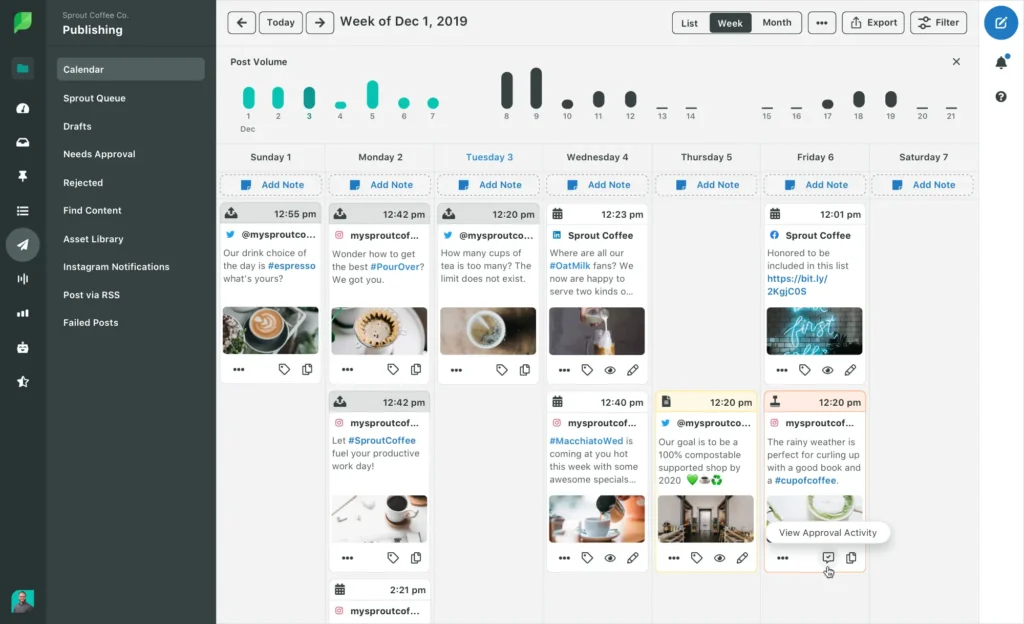

Who is Sprout Social best for?
Sprout Social is a great choice for larger organizations, agencies, and enterprises that need structure and detailed analytics and reporting.
Sprout Social feature overview
Sprout Social is a solid pick for teams that want to keep their social media organized without juggling too many tools. The unified inbox is a favorite: it pulls in messages, comments, and mentions from every channel so you can handle replies in one place instead of jumping around.
The calendar makes scheduling posts pretty straightforward, and the approval workflows help teams stay on the same page. Reporting is another strong point: the analytics are clear and easy to act on, so you’re not just staring at numbers but actually learning what works.
Here are Sprout Social’s key features:
- Connect with CRMs like Salesforce, help desks like Zendesk, and other tools to keep data and workflows in sync.
- Manage all social messages, comments, and mentions in one unified inbox.
- Use labels like “customer support” or “sales lead” to organize and prioritize responses.
- Plan, schedule, and publish across multiple social networks with a drag-and-drop content calendar.
- Keep content on track with built-in approval workflows.
- Boost Facebook and Instagram posts directly from Sprout to increase reach.
- Track hashtag performance and discover new ones to grow your audience.
- Build custom reports with the metrics that matter most to your team.
- Monitor conversations about your brand, industry, or products, even if you’re not tagged.
- Learn more about your audience’s demographics, interests, and behavior to guide content strategy.
- Measure sentiment in social conversations to refine your messaging.
- Find and collaborate with influencers and creators who fit your brand.
- Provide employees with pre-approved content they can share to expand your reach.
Sprout Social pros
Sprout Social gets a lot of praise for its clear reporting, simple interface, and team-friendly setup. The unified inbox is a big win for users who want to handle everything in one place, and the built-in workflows make it easier to keep projects moving. Many also like how straightforward it is to manage multiple accounts or clients without things getting messy.
What users are saying about Sprout Social’s pros:
- “I appreciate the approval workflows, internal notes, and shared content calendar, which really help our team stay aligned.” – Verified User in Sports (Source)
- “The analytics and reporting features are especially powerful-providing actionable insights that help us refine our campaigns and demonstrate ROI to stakeholders with confidence.” – Sara S., Executive Marketing Director (Source)
- “Ease of use! All is just plug and play. Fully automated for agencies with multiple clients like us.” – Verified User in Marketing and Advertising (Source)
- “We love the tagging capabilities to see what campaigns worked, what content to create, and what our community wants to see.” – Lauren D., Social Media Manager (Source)
- “The unified inbox is a game-changer. I’m able to see all mentions, comments, and messages across all of our platforms and it saves hours.” – Verified User in Health, Wellness and Fitness (Source)
Sprout Social cons
The most common complaint about Sprout Social is the price: many users feel it’s on the expensive side. Some features are only available on the higher-tier plans, which adds to the cost. There are also mentions of missing support for certain platforms, and a few users think the AI features and publishing tools still have room to grow.
What users are saying about Sprout Social’s cons:
- “Sprout Social can be quite expensive, especially for smaller teams or businesses. The cost increases significantly as you add more users or need access to premium features, which can be a barrier for scaling.” – Sara S., Executive Marketing Director (Source)
- “I dislike that I am not able to publish Instagram Stories from Sprout. This would help immensely as each time stories are posted now, it is natively through the app.” – Abby T., Senior Social Media Manager (Source)
- “You can’t connect to Reddit, Bluesky, and all the new social media.” – Alexia B., Digital Marketing Specialist (Source)
- “The base cost is already on the higher end, and then crucial features like social listening are locked behind an even more expensive add-on. This is frustrating, because listening is essential for proactive strategy, but it feels like it’s priced for enterprise budgets only.” – Verified User in Health, Wellness and Fitness (Source)
- “AI tools lacking in performance analysis.” – Verified User in Hospital & Health Care (Source)
Sprout Social pricing:
- Offers a 30-day free trial
- Paid plans start at $249/month
Sprout Social vs SocialPilot: Which one should you choose?
Choose SocialPilot if you need something affordable that can handle lots of accounts without overcomplicating things. It’s a solid option for freelancers, small teams, or agencies that mostly want straightforward scheduling, bulk uploads, and clear reports without paying for extras they won’t use.
Choose Sprout Social if your team needs more than just scheduling. The unified inbox, detailed reports, and workflow tools make it easier to manage campaigns across bigger teams or multiple departments. It costs quite a bit more, but if you’re running campaigns at scale and need social listening, tagging, and advanced analytics, it gives you the structure and insight SocialPilot doesn’t.
Frequently asked questions
Is SocialPilot the best tool for social media managers?
SocialPilot is useful if your main focus is easy scheduling across multiple social media accounts. It saves time with bulk scheduling and a simple calendar view, making it a solid option for basic publishing.
But for social media managers who need more than posting, like detailed social media analytics, a unified social inbox, and stronger collaboration tools, SocialPilot falls short. In that case, a more complete social media management platform such as SocialBee is often the better choice.
How to choose the best SocialPilot alternative?
Focus on what SocialPilot lacks for your workflow. If you need more than easy scheduling (like detailed social media analytics, a unified social inbox, stronger collaboration tools, or advanced scheduling across all major social media platforms), look for a social media management platform that combines publishing, engagement, and reporting in one place.
What is better than SocialPilot?
SocialPilot is good for quick scheduling, but it isn’t the strongest option for full social media management. Tools like SocialBee are better because they combine advanced scheduling, detailed social media analytics, a unified social inbox, and collaboration tools in one user-friendly platform. This makes it easier for small businesses, agencies, and teams to manage multiple social media accounts and improve overall social media performance.
Which tool will you choose to manage social media channels?
Choosing between these tools really comes down to what matters most for your workflow. If you just need a simple, quick way to schedule lots of posts, SocialPilot might be enough. But if you’d rather have deeper analytics, AI help with scheduling, and a cleaner way to manage messages across platforms, SocialBee is a stronger fit.
The best way to know what works for you is to try it out. SocialBee offers a 14-day free trial, so you can test it and see if it makes managing your channels easier.

